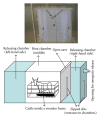Does Cattle Milieu Provide a Potential Point to Target Wild Exophilic Anopheles arabiensis (Diptera: Culicidae) with Entomopathogenic Fungus? A Bioinsecticide Zooprophylaxis Strategy for Vector Control
- PMID: 22934152
- PMCID: PMC3425831
- DOI: 10.1155/2012/280583
Does Cattle Milieu Provide a Potential Point to Target Wild Exophilic Anopheles arabiensis (Diptera: Culicidae) with Entomopathogenic Fungus? A Bioinsecticide Zooprophylaxis Strategy for Vector Control
Abstract
Background. Anopheles arabiensis is increasingly dominating malaria transmission in Africa. The exophagy in mosquitoes threatens the effectiveness of indoor vector control strategies. This study aimed to evaluate the effectiveness of fungus against An. arabiensis when applied on cattle and their environments. Methods. Experiments were conducted under semi-field and small-scale field conditions within Kilombero valley. The semi-field reared females of 5-7 days old An. arabiensis were exposed to fungus-treated and untreated calf. Further, wild An. arabiensis were exposed to fungus-treated calves, mud-huts, and their controls. Mosquitoes were recaptured the next morning and proportion fed, infected, and survived were evaluated. Experiments were replicated three times using different individuals of calves. Results. A high proportion of An. arabiensis was fed on calves (>0.90) and become infected (0.94) while resting on fungus-treated mud walls than on other surfaces. However, fungus treatments reduced fecundity and survival of mosquitoes. Conclusion. This study demonstrates for the first time the potential of cattle and their milieu for controlling An. arabiensis. Most of An. arabiensis were fed and infected while resting on fungus-treated mud walls than on other surfaces. Fungus treatments reduced fecundity and survival of mosquitoes. These results suggest deployment of bioinsecticide zooprophylaxis against exophilic An. arabiensis.
Figures




Similar articles
-
Ivermectin-treated cattle reduces blood digestion, egg production and survival of a free-living population of Anopheles arabiensis under semi-field condition in south-eastern Tanzania.Malar J. 2017 Jun 6;16(1):239. doi: 10.1186/s12936-017-1885-x. Malar J. 2017. PMID: 28587669 Free PMC article.
-
Feeding and resting behaviour of malaria vector, Anopheles arabiensis with reference to zooprophylaxis.Malar J. 2007 Jul 30;6:100. doi: 10.1186/1475-2875-6-100. Malar J. 2007. PMID: 17663787 Free PMC article.
-
Blood-feeding behaviour of the malarial mosquito Anopheles arabiensis: implications for vector control.Med Vet Entomol. 2006 Dec;20(4):425-37. doi: 10.1111/j.1365-2915.2006.652.x. Med Vet Entomol. 2006. PMID: 17199754
-
Role of cattle treated with deltamethrine in areas with a high population of Anopheles arabiensis in Moshi, Northern Tanzania.Malar J. 2007 Aug 8;6:109. doi: 10.1186/1475-2875-6-109. Malar J. 2007. PMID: 17686176 Free PMC article.
-
Are herders protected by their herds? An experimental analysis of zooprophylaxis against the malaria vector Anopheles arabiensis.Malar J. 2011 Mar 24;10:68. doi: 10.1186/1475-2875-10-68. Malar J. 2011. PMID: 21435266 Free PMC article.
Cited by
-
Made-to-measure malaria vector control strategies: rational design based on insecticide properties and coverage of blood resources for mosquitoes.Malar J. 2014 Apr 16;13:146. doi: 10.1186/1475-2875-13-146. Malar J. 2014. PMID: 24739261 Free PMC article. Review.
-
Sterilising effects of pyriproxyfen on Anopheles arabiensis and its potential use in malaria control.Parasit Vectors. 2013 May 17;6:144. doi: 10.1186/1756-3305-6-144. Parasit Vectors. 2013. PMID: 23683439 Free PMC article.
-
Eave tubes for malaria control in Africa: initial development and semi-field evaluations in Tanzania.Malar J. 2016 Sep 1;15(1):447. doi: 10.1186/s12936-016-1499-8. Malar J. 2016. PMID: 27586055 Free PMC article.
-
Parous rate and longevity of anophelines mosquitoes in bure district, northwestern Ethiopia.PLoS One. 2022 Feb 4;17(2):e0263295. doi: 10.1371/journal.pone.0263295. eCollection 2022. PLoS One. 2022. PMID: 35120146 Free PMC article.
-
Zooprophylaxis as a control strategy for malaria caused by the vector Anopheles arabiensis (Diptera: Culicidae): a systematic review.Infect Dis Poverty. 2017 Oct 25;6(1):160. doi: 10.1186/s40249-017-0366-3. Infect Dis Poverty. 2017. PMID: 29157310 Free PMC article.
References
-
- Kiszewski A, Mellinger A, Spielman A, Malaney P, Sachs SE, Sachs J. A global index representing the stability of malaria transmission. American Journal of Tropical Medicine and Hygiene. 2004;70(5):486–498. - PubMed
-
- Hadis M, Lulu M, Makonnen Y, Asfaw T. Host choice by indoor-resting Anopheles arabiensis in Ethiopia. Transactions of the Royal Society of Tropical Medicine and Hygiene. 1997;91(4):376–378. - PubMed
-
- Tirados I, Costantini C, Gibson G, Torr SJ. Blood-feeding behaviour of the malarial mosquito Anopheles arabiensis: implications for vector control. Medical and Veterinary Entomology. 2006;20(4):425–437. - PubMed
LinkOut - more resources
Full Text Sources

